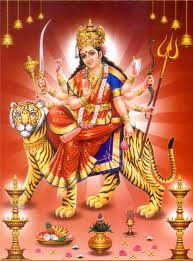| |
 As already mentioned,
the number of
aspects, both major
and minor, of DevI
or Sakti (i.e.,
ParvatI) is too
numerous to deal
with in a small book
like this. Apart
from the three major
ones dealt with so
far, a few others
which are more
commonly known will
now be dealt with
very briefly. As already mentioned,
the number of
aspects, both major
and minor, of DevI
or Sakti (i.e.,
ParvatI) is too
numerous to deal
with in a small book
like this. Apart
from the three major
ones dealt with so
far, a few others
which are more
commonly known will
now be dealt with
very briefly.
Annapurl)a: 'The
possessor and giver
of food.' ParvatI
got
this name since she
served food to Siva
when he was roaming
about as a
mendicant. She is
shown serving food
from a vessel of
ruby. Her worship
ensures that the
household will never
lack food. Her
temple at KasI is
very famous.
Aparajita: 'The
Invincible.' It is
actually one of the
names of Durga and
the wellknown series
of verses in the
Cal)qI ending with
the words 'namas
tasyai' are called 'Aparajitastotra'
.
Bala: 'The Child.'
Considered to be the
daughter of Lalita
and always nine
years old, she is
said to have
destroyed the thirty
sons of Bharyqasura.
BhadrakalI: One of
the several aspects
of MahakalI. She is
said to have sprung
from Vma's wrath
when Dak~a insulted
Siva and fought
along with
Vlrabhadra to
destroy Dak~a's
sacrifice.
BhUtamata: 'The
Mother of goblins.'
She resides under
the Asvattha (pi
pal) tree and has a
host of demons,
goblins and demigods
as her retinue.
Camunda: Same as
KalI. She got this
name since she
killed
Camunda in
the battle against
Sumbha and
Nisumbha. She is
sometimes included
under the
Saptamatrkas.
GayatrI, SavitrI and
SarasvatI: These
three goddesses
repre?sent the
presiding deities of
the famous GayatrI
Mantra chanted three
times a day. GayatrI
is the presiding
deity of the morning
prayer, rules over
the !J.gveda and the
Garhapatya fire. *
She has four faces,
four or ten arms and
rides on a swan.
SavitrI presides
over the noon
prayer, rules over
the Yajurveda and
the Dak~il)a fire.
She has four faces,
twelve eyes, four
arms and rides on a
bull. SarasvatI is
the deity presiding
over the evening
prayer, rules over
the Samaveda and the
Ahavanlya fire. She
has one face and
four arms, and rides
over Garuqa.
Indrakshi: "One whose
eyes are similar to
Indra's." She is the
aspect of DevI
specially worshipped
by Indra as also the
Apsara women
(heavenly damsels).
She is richly
decorated and holds
the Vajrayudha. If
she is
pleased by hymns,
she can cure even
incurable diseases.
Jagad-dhatrI: 'One
who sustains the
world.' Another
aspect of the DevI
which is more common
in Bengal. She has
four arms carrying
the conch, discus,
bow and arrow and
rides on a lion.
Kamesvari: 'The
Mistress of desire.'
Since Lord Siva
destroyed Kama, the
god of lust, he is
known as Kamesvara,
'One who is the lord
of lust or desire.'
The DevI being his
consort, is known as
KameSvarI. This is
actually one of the
names of Lalita. She
can fulfil any of
our desires for
which we supplicate
her.
Katyayani:: Since
the DevI was once
born as the daughter
of
a sage Kata by name,
she is known as
KatyayanI. She is
the totality of the
powers of the Hindu
Trinity. Her
description
practically tallies
with that of Durga
as Mahishasuramardini.
Manonmani:: 'One who
lifts the mind up to
the highest state of
Yoga.' She is the
Sakti established in
the psychic centre
in the top of the
head, just below the
Brahma?randhra. She
is pictured as blue
or black in
complexion and
carries a skull-cup
as also a sword.
When she is pleased
by the devoted
prayers of her
votaries, she can
grant wealth and
terrify their
enemies.
RajarajeSvarI: 'One
who rules over the
king of kings.' The
DevI is the mistress
of even Brahma,
Vi~t:lu and
MaheSvara as also
Kubera (the lord of
wealth), who are
known as 'king of
kings'. She is an
aspect of Lalita.
SivadutI: In her
battle against
Sumbha and Nisumbha,
the DevI once sent
her spouse Siva
himself as a
messenger (Duta) to
them. Hence she came
to be known as
SivadutI, 'one who
has Siva himself as
her messenger.'
Iconographically she
is sometimes shown
like KalI and
sometimes like Durga.
|
|

 As already mentioned,
the number of
aspects, both major
and minor, of DevI
or Sakti (i.e.,
ParvatI) is too
numerous to deal
with in a small book
like this. Apart
from the three major
ones dealt with so
far, a few others
which are more
commonly known will
now be dealt with
very briefly.
As already mentioned,
the number of
aspects, both major
and minor, of DevI
or Sakti (i.e.,
ParvatI) is too
numerous to deal
with in a small book
like this. Apart
from the three major
ones dealt with so
far, a few others
which are more
commonly known will
now be dealt with
very briefly.